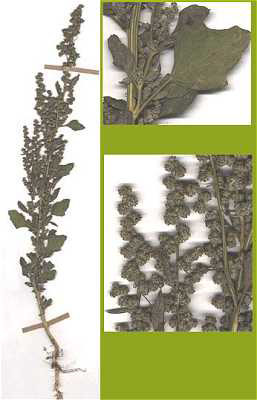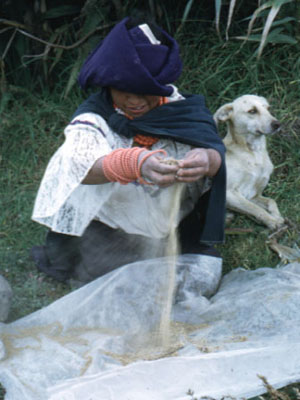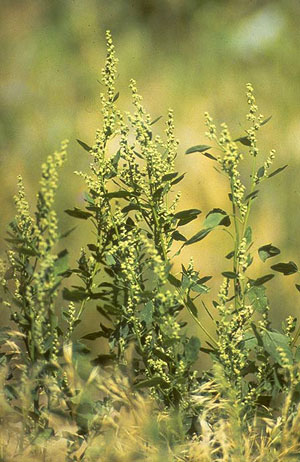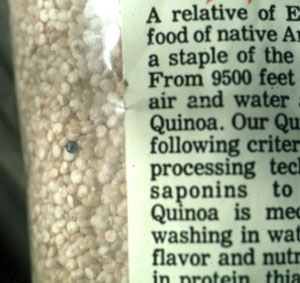Goosefoot, Huauzontle, Quelite, Bledo
Chenopodium spp.
Chenopodiaceae (Goosefoot Family)
Goosefoot, huauzontle, quelite, and bledo are common names for a leafy plant that Indian tribes, indeed civilizations throughout the Americas relied upon for food. The common names refer to several annual species in the genus Chenopodium that produce thousands of seed-like fruits on a single flower stalk, as well as vitamin and mineral-packed leaves that were harvested for greens. There are dozens of species that grow in Europe and the Americas -- about 29 in Texas.
Native Americans not only utilized several wild species of goosefoot, they also domesticated Chenopodium in at least three different regions of the Americas -- in the Andes of South America, in Middle America, and in the Eastern Woodlands of North America. One species, Chenopodium quinoa, or quinoa (KEEN-wah), was domesticated in the South American Andes about 5,000 years ago. The fruit of this plant, a seedlike "achene", is cultivated commercially and is growing in popularity as a replacement for grains such as rice, wheat, and oats. Quinoa is available in many grocery stores in the natural food section or in just about every natural foods store.
Another species, Chenopodium berlandieri, is one of four plants that were actually domesticated in the Eastern Woodlands of North America prior to the introduction and wide utilization of corn (maize). The oldest examples of domesticated Chenopodium berlandieri predate 3500 B.P. The third domesticate, Chenopodium berlandieri subsp. nuttalliae (Huauzontle) was grown in Mexico, and is now grown commercially for its colorful (green and red) leafy foliage. Served in salads at restaurants, it now goes by the moniker, Red Aztec Spinach. The Aztec actually utilized different cultivars of this plant for the greens and the abundant fruits that were produced on tall flower stalks.
Archeology. We have not discovered the seeds of domesticated Chenopodium in Texas, but we know that several wild species, including wild types of Chenopodium berlandieri, were used by Native Americans. The archeological record suggests that they were used by Native Americans living in the region we know as southern Texas and northern Mexico. Several seeds identified as cheno-ams were recently recovered from an Indian campsite in Maverick County near Eagle Pass, Texas. Archeologists use the term cheno-am to refer to the carbonized seeds of either Chenopodium or Amaranthus, because extreme heat often destroys identifying sculpture on the seed or fruit coat making it impossible to tell seeds of the two genera apart.
Although leaves are seldom preserved in open archeological sites, both the young leaves and the ripened seeds of goosefoot and pigweed could have provided a food source. The seed may be considered proxy evidence for the use of the plant in all its forms.
Few cheno-am seeds have been recovered from archeological sites in Texas. This is probably due to the fact that the seeds are small, and are often recovered from heating or storage facilities in pithouse or pueblo contexts in the desert Southwest which provide a better environment for concentrating seeds and preserving them than the briefly occupied campsites excavated in Texas. Because the ephemeral hunter-gatherer sites of Texas do not provide such opportunities for preservation, the recovery of cheno-am seeds has been limited. Several charred seeds identified as comparing favorably to Chenopodium berlandieri were recovered from Late Prehistoric contexts at the Hinojosa Site (41JW8) in Jim Wells County on the eastern side of the Rio Grande Plains, and more recently from 41MV164 in Maverick County near Eagle Pass.
Food Uses. Unlike prickly pear and mesquite, there are no ethnohistoric references to the use of chenopods in the South Texas Plains. This has a lot to do with the very poor ethnographic and historic records available for the entire state. However, there is a wealth of information available from sources outside the state, and it is likely that the Indians of the South Texas Plains utilized Chenopodium in a similar manner to those living in other parts of North America
The wild type of Chenopodium berlandieri is the best studied of all the members of the genus. The foliage is rich in calcium and vitamin A, comparable to spinach. Nutritional studies are not available for wild-type seeds of Chenopodium, but studies of quinoa indicate it is comparable to wheat in energy and superior in protein because it contains more lysine and a well-balance suite of amino acids. It lacks gluten, a common allergen found in wheat. It is also higher in calcium, phosphorus, magnesium, potassium, iron, copper, manganese, and zinc than any of the cereal grasses (rice, wheat, barley, oats, or corn/maize).
Before Chenopodium, including quinoa, can be consumed, biochemical toxins must be removed. The seeds are coated with saponins, chemicals with detergent-like properties that foam when water is added and that tend to damage animal cells when consumed. Saponin is a useful chemical defense against herbaceous predators, but it's hard on the stomach. Commercial growers process the seeds to remove the saponins before they are sold in the grocery store. Also, Chenopodium foliage contains high concentrations of nitrates, considered toxic to anything that consumes them. The commercial cultivars grown for foliage and used in salads, don't concentrate nitrates as quickly as wild types and are picked young and before they have had time to concentrate toxic levels in the leaves.
Because Chenopodium is distributed so widely across the Americas, the ethnographic literature contains dozens of references to its use. The North American ethnography is a bit confusing, however, because many of the ethnographic references either misidentify the species, or they refer to the use of species that are Old World introductions. Suffice to say that the use of most of the members of the genus is probably quite similar.
As in the domesticated species, both the seeds and the foliage of wild goosefoot plants were consumed. References to consumption of the foliage or fresh "greens" were more common than those mentioning the consumption of the seeds. Because some of the leaves contain concentrations of nitrates which are toxic, most ethnographies note that the young leaves were collected, and some were carefully leached. In fact, the Tarahumara were careful to choose young plants and leach them. Other groups using the greens of Chenopodium were the Cherokee, Dakota, Brule, Navajo, Hopi, Mescalero, Chiricahua, Pima, Papago, Tarahumara, Yavapai, Diegueño, Kawaiisu, and many others. Commonly they boiled them, and the more detailed accounts note that the younger plants or leaves were picked for this purpose. Younger foliage has had less time to accumulate toxins, and boiling followed by rinsing further reduces any toxic accumulations in the leaves.
The greens were often mixed with other foods. The Papago mixed the greens with baked cholla cactus buds in a meatless stew. The Chiricahua and Mescalero ate them raw, or cooked them with green chiles and meat or soup bones. By contrast, the White Mountain Apache enjoyed greens raw or stone-boiled in a basket, but never ate them with meal. In an interesting variation of preparation, the Miwok in California boiled and then dried the greens for storage. It is likely that the use of greens varied among families as well as between groups, and that there were many other ways to prepare or utilize greens that were never recorded.
References to eating the seeds are not as common, perhaps because they were augmented by maize in many groups before Europeans arrived, and then by other Old World cereal crops after Europeans arrived. The Papago once utilized small seeds of many kinds, including Chenopodium, but had discontinued the practice by the 20th century. The Cahuilla harvested Chenopodium seeds and ground them into flour. The harvest was kept in large granaries on the canyon rims. The Yavapai harvested the seeds in a manner similar to amaranth, then parched them on hot coals and ground them into flour.
Medicine and Other Uses. The saponins produced in Chenopodium is often concentrated in the roots and nitrates in the foliage. For this reason there are some useful applications that utilize the all parts of the plant. The Tarahumara steeped Chenopodium leaves into a decoction of increasing strength to reduce fever and treat intestinal worms. The Navajo used the plant to treat bruises. The Cahuilla used the long taproot of Chenopodium californicum as soap, storing it and grating it as needed. Many other other groups in California used Chenopodium californicum for soap.
References
Barrett, S. A. and E. W. Gifford
1933 Miwok Material Culture. Bulletin of the Public Museum of the City of Milwaukee 2(4):117-376.
Buskirk, Winfred
1986 The Western Apache: Living with the Land Before 1950. University of Oklahoma Press. Norman.
Bye, Robert A., Jr.
1981 Quelites -- Ethnoecology of Edible Greens -- Past, Present, and Future. Journal of Ethnobiology 1:109-123.
Castetter, E. F, and Willis H. Bell
1942 Pima and Papago Indian Agriculture. The University of New Mexico Press, Albuquerque.
Castetter, E. and W. Bell
1951 Yuman Indian Agriculture. University of New Mexico Press, Albuquerque.
Castetter E. F., and R. Underhill
1935 The Ethnobiology of the Papago Indians. Ethnobiological Studies in the American Southwest. Vol. II. The University of New Mexico Bulletin, Biological Series 4(3). Albuquerque.
Dering, J. Phil
2005 Plant Remains from 41MV164. Unpublished ms. Submitted to GTI, Inc. Austin.
Fritz, Gayle J.
1984 Identification of Cultigen Amaranth and Chenopod from Rockshelter Sites in Northwest Arkansas. American Antiquity 49:558-572.
Gifford, F.
1936 Northeastern and Western Yavapai. University of California Publications in American Arhcaeology and Ethnography 31:257-334.
Hodgson, Wendy
2001 Food Plants of the Sonoran Desert. University of Arizona Press, Tucson.
Jones, J.G.
1986 Macrobotanical Materials. In The Clemente and Herminia Hinojosa Site, 41JW8: A Toyah Horizon Campsite in Southern Texas, by Stephen L. Black, pp. 137- 144. Center for Archaeological Research, Special Report No. 18. The University of Texas at San Antonio. San Antonio, Texas.
Pennington, C.
1963 The Tarahumara of Mexico: Their Environment and Material Culture. University of Utah Press, Salt Lake City.
Smith, Bruce D.
1998 The Emergence of Agriculture. Scientific American Library. New York.
Wilson, Hugh, and Charles Heiser.
1979 The Origin and Evolutionary Relationship of "Huauzontle", Domesticated Chenopod of Mexico. American Journal of Botany 66:198-206.
Wyman, Leland C. and Stuart K. Harris
1951 The Ethnobotany of the Kayenta Navaho. The University of New Mexico Press. Albuquerque.

Views of the stem, leaves, and seed of Chenopodium berlandieri. Parts of this plant are exceedingly high in nutrients. Photo by Hugh Wilson, courtesy of Vacular Plant Image Library, Texas A&M University. |

An Ecuadorean woman winnows chaff from seed of Chenopodium quinoa. Photo by Van Reidhead, courtesy of Vacular Plant Image Library, Texas A&M University. |

